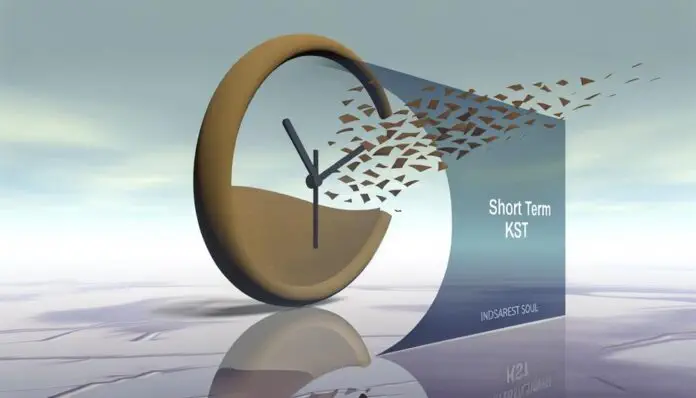Imagine being a trader, closely monitoring the swift changes in the stock market. You come across the Short Term KST indicator – a tool that piques your interest due to its renown for precisely tracking quick shifts in market momentum.
As a professional, you know that understanding the undercurrents of market movements is crucial, and Short Term KST promises an edge by providing a clear picture of the rate of change in price action. You're aware that it can signal potential entry and exit points, but like any sophisticated tool, it requires a keen sense of interpretation.
The question lingers in your mind: how can you harness the Short Term KST to refine your trading strategy and what nuances should you be wary of when integrating it with other indicators? This uncharted territory beckons with the promise of enhanced market insights, but it's essential to proceed with a meticulous approach to fully leverage its potential.
Key Takeaways
- Short-Term KST is a momentum oscillator used to gauge the velocity of market movements.
- The KST indicator is calculated by applying a simple moving average (SMA) on four different Rate of Change (ROC) periods.
- KST signals provide insights into momentum shifts and potential trading opportunities.
- The KST indicator helps in better timing trades by understanding market behavior.
Defining Short-Term KST
The Short-Term KST, or Know Sure Thing, is a momentum oscillator that you can use to gauge the velocity of market movements over different periods, helping to clarify rate-of-change data for more informed trading decisions. Developed by Martin Pring, the KST indicator simplifies the technical analysis by signaling the momentum trends within multiple timeframes.
To compute the KST, you'll apply the simple moving average (SMA) on four different Rate of Change (ROC) periods. These ROCs are essentially the engines that power the KST, providing a clearer picture of the momentum by smoothing out the volatility of daily price movements. The Smoothed ROCs are then combined to form the indicator line, which you'll analyze to spot shifts in the market trend.
A crucial aspect of the KST indicator is the signal line, which is typically a 9-period SMA of the KST itself. This line acts as a benchmark for generating trade signals. You're on the lookout for when the KST crosses over its signal line, which suggests a potential bullish momentum. Conversely, when the KST crosses below the signal line, it may indicate a bearish turn in the market.
For a more robust trading strategy, it's advisable to complement the KST indicator with other forms of technical analysis. This multifaceted approach can bolster your confidence in the signals you're receiving, especially since the KST excels in trending markets rather than in sideways or ranging markets.
Calculating Short-Term KST

Now that you understand what Short-Term KST is and its significance in market analysis, let's focus on how to calculate this momentum oscillator to enhance your trading strategy.
The Know Sure Thing (KST) is a momentum indicator crucial for technical analysis and helps in discerning market trends. Here is how you can calculate the Short-Term KST:
- Calculate the Rate of Change (ROC): Determine the ROC for four different time periods. The ROC uses the formula \((ext{Current Price} – ext{Price from 'X' periods ago}) / ext{Price from 'X' periods ago}\) multiplied by 100.
- Smooth the ROC: Apply a simple moving average (SMA) to each of the four ROC values to get the Smoothed ROC. The time periods for the SMAs typically vary, with shorter periods used for the short-term KST.
- Combine the Four Smoothed ROCs: Multiply each Smoothed ROC by a weighting factor (which is different for each of the four ROCs) and sum them up to calculate the KST. This step integrates the momentum information from different time frames.
- Generate the Signal Line: The signal line is the 9-period SMA of the KST itself. Indicator Trading signals are generated when the KST crosses this signal line.
To effectively use the KST in your trading, it's important to note that it's best suited for trending markets. The oscillator developed by Martin Pring can help you decide when to go long or short. However, remember that calculating short-term KST is just one part of your analysis; it's vital to confirm signals with additional technical indicators for a robust trading approach.
Analyzing KST Signals

Understanding KST signals can significantly enhance your market analysis, as these indicators provide valuable insights into momentum shifts and potential trading opportunities. The KST, or Know Sure Thing, is a technical indicator that serves as a momentum oscillator, similar to the relative strength index (RSI). It's crucial for you to recognize trading signals, which typically occur when the KST crosses its signal line. This could indicate a change in momentum, alerting you to possible entry or exit points in the financial markets.
Analyzing KST signals requires attention to detail. Overbought or oversold conditions can be identified, which may suggest an impending reversal. Moreover, you should be on the lookout for bullish or bearish divergences. A bullish divergence arises when the price records a lower low, but the KST marks a higher low, potentially signaling an upward price movement. Conversely, bearish divergence occurs when the price hits a higher high, but the KST indicates a lower high, hinting at a possible price decline.
Here's a table to help illustrate the primary KST signal interpretations:
| KST Signal | Market Condition | Potential Action |
|---|---|---|
| KST crosses up signal | Bullish Momentum | Consider buying |
| KST crosses down signal | Bearish Momentum | Consider selling |
| Bullish divergence | Potential Reversal (Up) | Monitor for buy signal |
| Bearish divergence | Potential Reversal (Down) | Monitor for sell signal |
| Overbought/Oversold | Exhausted Trend | Prepare for reversal |
It's important to use KST signals in combination with other indicators to validate the trading signals and avoid false alarms. Analyzing KST signals in trending markets, as opposed to sideways markets, usually yields more reliable results. Always integrate these signals into a comprehensive trading strategy for the best outcomes.
KST in Market Trends

While KST signals are invaluable for pinpointing momentum shifts, they're also powerful tools for analyzing overarching market trends to better time your trades. The Know Sure Thing (KST) indicator is more than a quick glance at market dynamics; it's a nuanced instrument that can guide you through the intricacies of market behavior.
Here's how you can leverage the KST in understanding and capitalizing on market trends:
- Identifying the Underlying Trend: The KST's primary role is to reveal the underlying trend. A rising KST suggests bullish momentum, indicating that it may be time to consider buy positions. Conversely, a falling KST can signal bearish momentum, prompting a closer look at sell opportunities.
- Signal Line Crossovers: Trading signals are generated when the KST crosses its signal line. For example, if the KST crosses above the signal line, it's a potential buy signal, hinting that the trend is gaining upward momentum. A cross below may serve as a sell signal, suggesting weakening momentum.
- Zero Line Crossings: The KST crossing above or below the zero line can signal a shift in overall market sentiment. A move above the zero line indicates strength and could validate a bullish market trend, while dropping below may signal the start of a bearish phase.
- Divergence Detection: Technical analysis often involves looking for divergences between an indicator and price action. If the KST forms highs or lows that diverge from those of the price, it could be a warning of a potential trend reversal, providing a strategic advantage in your trading.
Comparing KST With Other Indicators

When comparing the KST to other popular indicators like MACD and RSI, it's crucial to note its unique focus on the rate-of-change in price data, offering insights distinct from its counterparts. The KST, or Know Sure Thing, is a momentum oscillator that zeroes in on ROC values, providing a different perspective on market dynamics. This sets it apart from the Moving Average Convergence Divergence (MACD), which relies on the relationship between two moving averages, and the Relative Strength Index (RSI), which measures the magnitude of recent price changes to evaluate overbought or oversold conditions.
In your comparison, you'll find that while the MACD is excellent for identifying the momentum behind a trend, the KST offers a more nuanced view by minimizing short-term noise and emphasizing longer-term trends. This can be particularly valuable when you're looking to confirm the strength of a given trend.
Meanwhile, the RSI's focus on price extremes can complement the KST by highlighting potential reversals.
Using KST alongside these technical indicators can be a versatile tool in your trading arsenal. It excels in identifying the direction and strength of market trends, and when used in conjunction, can help you weed out false signals. For instance, if the KST indicates a strong trend but the MACD suggests weakening momentum, you might proceed with caution.
Frequently Asked Questions
Is KST a Good Indicator?
You'll find the KST indicator reliable for momentum analysis and spotting market trends. Its interpretation aids in crafting entry strategies and generating trading signals, but always cross-check with volume correlation and technical comparison.
What Is the Difference Between MACD and Kst?
You're comparing MACD basics with KST origins; MACD tracks trend momentum while KST analyzes rate changes. Their signals differ, aiding diverse trading strategies through divergence analysis and trend identification in technical analysis.
What Does KST Mean Stocks?
KST stands for "Know Sure Thing," a technical analysis tool you'll use to gauge momentum, refine entry signals, and craft exit strategies by observing market trends and chart patterns for enhanced indicator reliability.
How Do You Read a KST Indicator?
To read a KST indicator, you'll analyze momentum measurement and trend analysis. Look for KST signals crossing the signal line, and integrate them into your chart for informed trading strategies and signal interpretation.
Conclusion
You've now explored the Short-Term KST, a powerful tool for gauging market momentum. By understanding how to calculate and interpret its signals, you can better navigate trends and make informed trades.
Pairing KST with other indicators enhances your strategy, giving you a clearer market picture. Embrace KST's insights and use them alongside your analysis tools to refine your trading decisions and stay ahead of the curve.



